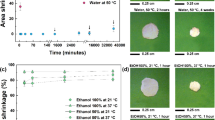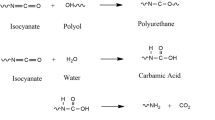The effect of hollow glass microspheres with a density of 125 kg/m3 on the properties of low-density (54-90 kg/m3) rigid polyurethane foams is investigated. The thermal expansion coefficient of the foams and their properties in tension and compression in relation to the content of the microspheres (0.5-5 wt.%) are determined. An increase in the characteristics of the material in compression in the foam rise direction with increasing content of filler is revealed. The limiting content of the microspheres above which the mechanical characteristics of the filled foams begin to decrease is found. The distribution of the microspheres in elements of the cellular structure of the polyurethane foams is examined.








Similar content being viewed by others
References
W. Francis, M. Tupper, and S. Harrison, “Conformable tile method of applying CryoCoat™ UL79 insulation to cryogenic tanks,” Advances in Cryogenic Engineering Trans. Cryog. Eng. Conf. , CEC. AIP Conf. Proc., 710, 627-634 (2004).
Russ. Federat. Patent 2342415, A Liquid-Ceramic Insulation Covering. Appl. 10.07.2007, Publ. 27.12.2008, Otkryt. Izobret.
L. A. Dombrovsky, J. H. Randrianalisoa, and D. Baillis, “Infrared radiative properties of polymer coatings containing hollow microspheres,” Int. J. Heat Mass Transfer, 50, 1516-1527 (2007).
A. A. Berlin and F. A. Shutov, Reinforced Gas-Filled Plastics [in Russian], Khimiya, Moscow (1980).
F. A. Shutov, Integral/Structural Polymer Foams: Technology, Properties and Applications, Springer-Verlag, Berlin (1986).
I. I. Sokolov, M. G. Dolmatovskii, I. S. Deev, and V. Ya. Stetsenko, “Effect of the physicomechanical characteristics of hollow glass microspheres on the properties of spheroplasts,” Plast. Massy, No. 7, 16-18 (2005).
V. B. Chalivendra, A. Shukla, A. Bose, and V. Parameswaran, “Processing and mechanical characterization of lightweight polyurethane composites,” J. Mater. Sci., 38, 1631-1643 (2003).
H. S. Kim and P. Plubrai, “Manufacturing and failure mechanisms of syntactic foam under compression,” Composites. Part A, 35, 1009-1015 (2004).
S. J. Park, F. L. Jin, and A. J. Lee, “Preparation and physical properties of hollow glass microspheres-reinforced epoxy matrix resins,” Mater. Sci. Eng. A., 402, 335-340 (2005).
P. Li, N. Petrinic, C. R. Siviour, R. Froud, and J. M. Reed, “Strain rate-dependent compressive properties of glass microballoon epoxy syntactic foams,” Mater. Sci. Eng. A, 515, Iss. 1-2, 19-25 (2009).
N. Gupta and V. C. Shunmugasamy, “High strain rate compressive response of syntactic foams: Trends in mechanical properties and failure mechanisms,” Mater. Sci. Eng. A, 528, Iss. 25-26, 7596-7605 (2011).
E. Barber, J. Nelson, and W. Beck, “Improving properties in rigid urethane foams using glass bubbles,” J. Cellul. Plastics, 13, Nov., 383-387 (1977).
J. A. Hagarman, J. P. Cunnion, and B. W. Sands, “Formulation and physical properties of polyurethane foam incorporating hollow microspheres,” J. Cellul. Plastics, 21, Jan., 406-408 (1985).
Xiang-Cheng Bian, Jian-Hua Tang, and Zhong-Ming Li, “Flame retardancy of hollow glass microsphere/rigid polyurethane foams in the presence of expandable graphite,” J. Appl. Polym. Sci., 109, Iss. 3, 1935-1943 (2008).
I. V. Masik, N. V. Sirotinkin, S. V. Yatsenko, and S. V. Vakulenko, “Effect of glass microspheres on the properties of rigid polyurethane foams,” Plast. Massy, No. 1, 41-46 (2002).
P. Yu. Blinnikov, E. V. Bykova, A. A. Dorofeyev, and G. Kh. Korshunova, “Effect of ash microspheres on the properties of rigid polyurethane foams,” Tekhnol. Metals, No. 3, 30 (2008).
L. P. Varlamova, V. A. Izvozchikova, A. S. Averchenko, Yu. D. Semchikov, and S. A. Ryabov, “Effect of aluminosilicate microspheres on the physicomechanical and rheological properties of rigid polyurethane foams,” Zh. Prikl. Khim., 81, No. 3, 502-504 (2008).
O. G. Tarakanov, I. V. Shamov, and V. D. Alperin, Filled Plastic Foams [in Russian], Khimiya, Moscow (1988).
V. Yakushin, U. Stirna, L. Belkova, L. Deme, and I. Sevastyanova, “Properties of rigid polyurethane foams filled with milled carbon fibers,” Mech. Compos. Mater., 46, No. 6, 679-688 (2011).
Author information
Authors and Affiliations
Corresponding author
Additional information
Translated from Mekhanika Kompozitnykh Materialov, Vol. 48, No. 5, pp. 835-846, September-October, 2012.
Rights and permissions
About this article
Cite this article
Yakushin, V., Bel’kova, L. & Sevastyanova, I. Properties of rigid polyurethane foams filled with glass microspheres. Mech Compos Mater 48, 579–586 (2012). https://doi.org/10.1007/s11029-012-9302-6
Received:
Revised:
Published:
Issue Date:
DOI: https://doi.org/10.1007/s11029-012-9302-6




